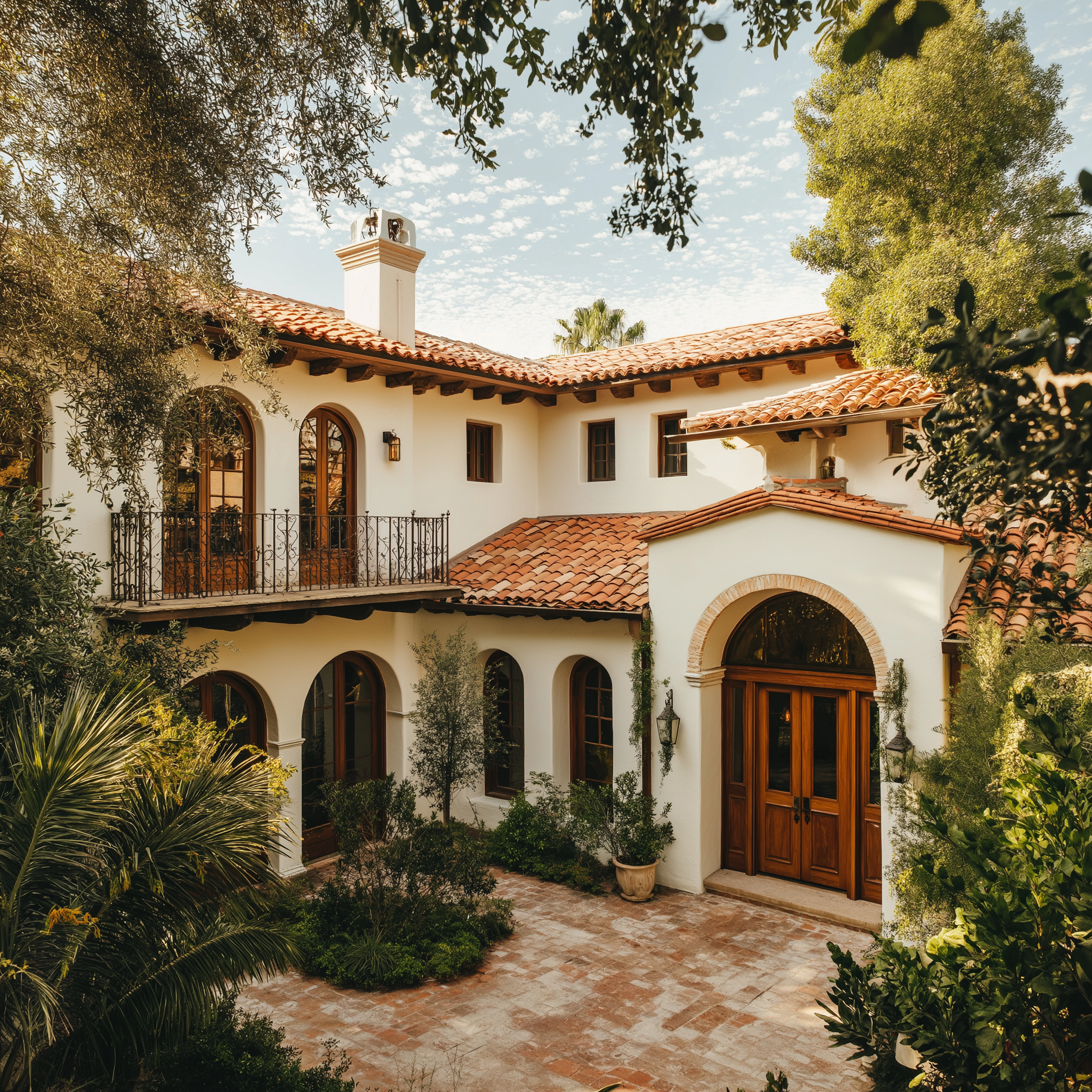Mediterranean Home Design Ideas for a Sophisticated Coastal Aesthetic
Table of Contents
Introduction
Imagine terracotta rooftops, arched doorways, sun-washed walls, and olive trees swaying in a coastal breeze. Mediterranean home design draws inspiration from the timeless architecture of Spain, Greece, Italy, and Southern France, offering a blend of old-world charm and relaxed sophistication. It’s a look that evokes vacation vibes year-round—while still feeling elevated and liveable.
According to a 2023 trend report by Architectural Digest, Mediterranean-inspired interiors saw a 40% increase in Pinterest saves compared to the year before, as homeowners seek calming, sun-kissed alternatives to minimalism and modern farmhouse.
In this guide, we’ll explore elegant Mediterranean home design ideas to help you capture this coastal aesthetic in a refined, curated way. Whether you’re refreshing a room or redesigning your entire home, these principles will help you achieve a look that’s breezy yet luxurious.
Outline
1. Start with a Warm, Earthy Color Palette
- Use creamy whites, soft taupes, warm terracottas.
- Accent with sea-inspired hues like azure, sage, and olive green.
- Keep bold colors to accessories or wall niches.
Table: Mediterranean Color Combinations
| Base Color | Accent Colors | Recommended Use |
| Creamy White | Olive, Terracotta | Walls, ceilings, trim |
| Warm Sand | Deep Blue, Burnt Umber | Flooring, upholstery |
| Pale Grey | Mustard, Turquoise | Bathroom/kitchen accents |
2. Incorporate Arches and Architectural Details
- Arched doorways or alcoves evoke Mediterranean architecture.
- Use curved mirrors or windows to echo these forms.
- Consider arched built-ins or fireplaces for visual interest.
3. Embrace Natural Materials and Textures
Flooring
- Terra cotta tiles, rustic stone, or light-washed wood planks.
Surfaces
- Limewashed walls, plaster finishes, raw-edge wood tables.
Textiles
- Linen, cotton, jute, and sisal in muted or earthy tones.
4. Add Wrought Iron and Rustic Metals
- Use wrought iron in stair railings, light fixtures, or coffee tables.
- Incorporate brass or antique bronze hardware in kitchens and baths.
- Avoid polished chrome; opt for matte, weathered finishes.
5. Create Indoor-Outdoor Living Flow
- Large doors or windows that open to patios or gardens.
- Use natural fiber rugs, rattan seating, and Mediterranean planters.
- Include climbing vines, citrus trees, or olive branches.
Table: Mediterranean Plant Picks for Decor
| Plant Type | Style Contribution | Ideal Location |
| Olive Tree (indoor) | Silvery green tone, sculptural | Corners, entryways |
| Lavender | Fragrance and rustic appeal | Kitchen, sunny balcony |
| Potted Citrus Tree | Pop of color and fragrance | Patio, sunroom |
| Ivy or Vines | Organic, European garden aesthetic | Over doors or trellises |
6. Focus on Curated, Timeless Furnishings
- Choose carved wooden furniture with Mediterranean curves.
- Avoid over-decorating—Mediterranean interiors are layered, not cluttered.
- Mix antiques with contemporary linen sofas or woven textures.
7. Use Pattern with Purpose
- Incorporate traditional Mediterranean patterns: tile motifs, mosaic, or hand-painted ceramics.
- Keep patterned pieces limited to floors, backsplashes, or textiles.
- Balance with neutrals and solid fabrics to prevent visual overload.
8. Add Subtle Global Decor Accents
- Use hand-painted ceramics, Moroccan poufs, or Grecian urns.
- Choose statement pieces like a large amphora or carved wood mirror.
- Avoid overly trendy items—opt for heirloom-quality accents.
Detailed Content Expansion
1. Start with a Warm, Earthy Color Palette
Mediterranean design starts with a palette that mimics the sun, sea, and soil of coastal Europe. The effect is natural, calming, and timeless.
Choose Earth-Derived Neutrals
Your base should consist of soft whites, creams, and warm sand tones, reminiscent of stone walls and sun-bleached surfaces. These hues set the stage for texture and warmth while keeping spaces light and airy.
Layer in Nature-Inspired Accents
Add colors found in Mediterranean landscapes:
- Olive green for foliage and tranquility.
- Terracotta and clay for warmth and earthiness.
- Deep blues and aquas to reflect the sea.
Keep these shades reserved for accents like ceramics, cushions, tilework, or artwork. This method keeps the space balanced, airy, and sophisticated rather than rustic or overly colorful.
Paint Tip: Use limewash or textured finishes to create depth on walls. Brands like Portola or Bauwerk offer mineral-based paints that deliver an old-world feel.
Table: Mediterranean Paint Palette Inspiration
| Color Name | Best For Use In | Recommended Brand |
| “Alabaster” White | Ceilings, walls | Sherwin-Williams |
| “Roman Clay” Terracotta | Accent wall, niche | Portola Paints |
| “Mediterranean Blue” | Front door, ceramics | Benjamin Moore |
| “Olive Grove” | Cabinetry, planters | Behr |
3. Embrace Natural Materials and Textures
One of the key pillars of Mediterranean design is the use of organic materials and tactile finishes. The look is effortless and unfussy—but rich in sensory detail.
Start with the Foundation
Flooring sets the tone. Choose from:
- Terracotta tiles for a traditional Tuscan feel.
- Rustic stone or limestone for an old-world ambiance.
- Light-washed hardwoods for a cleaner, coastal look.
Finish with Textural Surfaces
Walls should have a matte, soft finish—limewash, Venetian plaster, or a paint treatment that mimics natural imperfections. Open shelving in raw-edge wood or matte stone enhances the handcrafted appeal.
Layer Organic Textiles
Use materials that breathe:
- Linen slipcovers or curtains for softness.
- Jute and sisal rugs for natural grounding.
- Cotton or hemp throws for added warmth and texture.
Avoid glossy finishes or synthetic fabrics. The Mediterranean aesthetic thrives on materials that age well and embrace imperfection.
Table: Material Guide for Mediterranean Interiors
| Material | Use Case | Style Benefit |
| Terracotta Tile | Floors, stair risers | Rustic warmth |
| Linen | Drapes, bedding, slipcovers | Airy, breathable texture |
| Plaster Finish | Walls, niches, fireplace | Handcrafted, organic appeal |
| Wrought Iron | Lighting, railings, curtain rods | European architectural charm |
Design Tip: Stick to matte or low-sheen finishes to maintain a relaxed, understated elegance.
Conclusion
A Mediterranean-style home is more than a look—it’s a lifestyle. It reflects a love for nature, heritage, and slow living, all while maintaining an air of refinement. By embracing warm neutrals, natural textures, curated details, and a seamless indoor-outdoor connection, you can craft a space that evokes the breezy elegance of coastal Europe.
Whether you’re renovating a full home or refreshing a single room, the Mediterranean design ethos offers a versatile and timeless approach to sophisticated coastal living. Rooted in centuries-old traditions yet easy to modernize, it’s a style that transcends trends while inviting comfort and beauty into everyday life.

